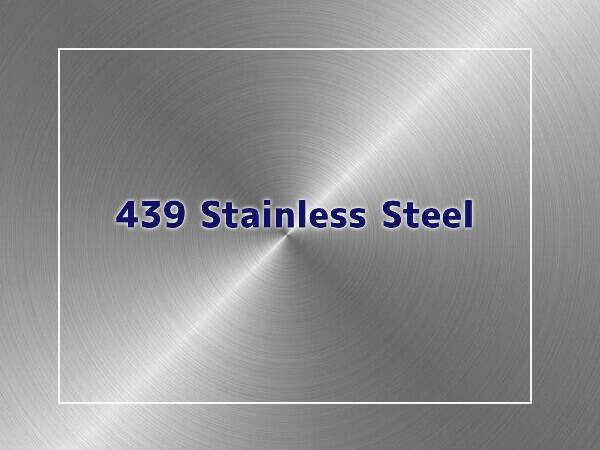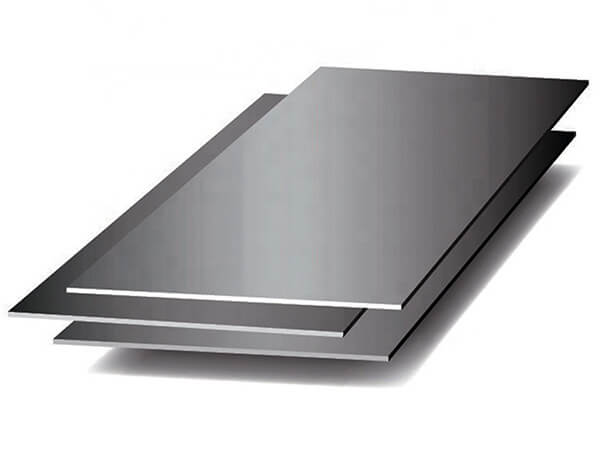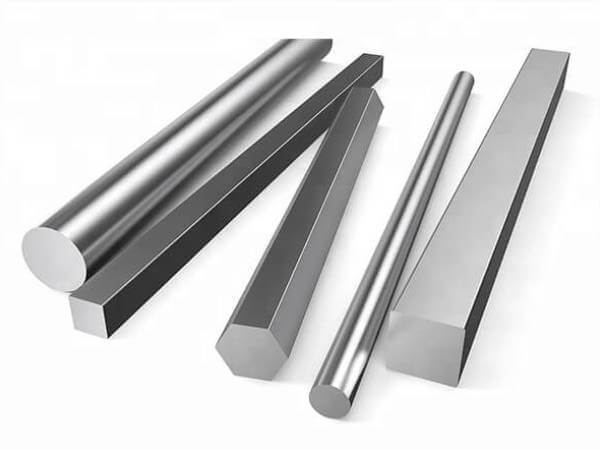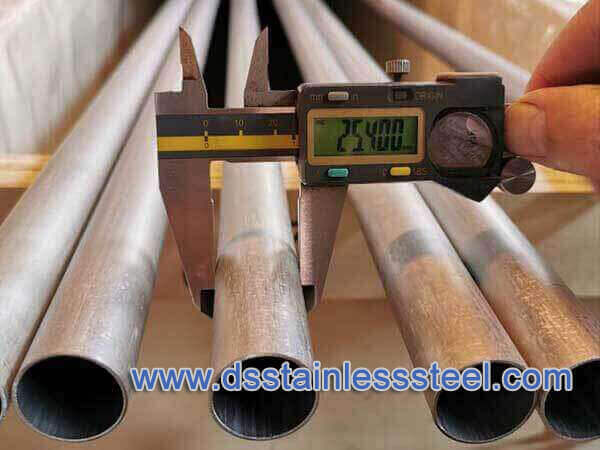
439 stainless steel is a titanium stabilized ferritic stainless steel grade with, 18 percent chromium alloy, it is designed to resist corrosion in a variety of oxidizing environments from freshwater to boiling acids, and its corrosion resistance is similar to that of 304/304L stainless steel. Type 439 may also be used in many oxidizing environments where Type 304 is considered adequate in terms of general corrosion resistance but is subject to chloride stress corrosion cracking. This variation does not require annealing after welding to restore ductility or to provide intergranular corrosion resistance. Type 439 also has superior formability capabilities and is heavily used in the automotive industry; it can be work-hardened slightly to increase tensile strength.
Excellent resistance to stress corrosion cracking, good weldability, high thermal conductivity and low thermal expansion characteristics make Type 439 stainless steel an ideal consideration for many applications, typical applications include tubular manifolds and exhaust system components.
439 Stainless Steel Chemical Composition
| Grade | C | Si | Mn | P | S | Cr | Ni | N | Ti | Fe |
|---|---|---|---|---|---|---|---|---|---|---|
| 439 | 0.030 | 1.00 | 1.00 | 0.040 | 0.030 | 17.00 – 19.00 | 0.5 | 0.030 | [0.20+4(C+N)] min, 1.10 max; | Bal |
439 Stainless Steel Mechanical Properties
| Grade | Tensile Strength (MPa) min | Yield Strength 0.2% Proof (MPa) min | Elongation (% in 50mm) min | Hardness Rockwell B (HR B) max | Hardness Brinell (HB) max |
|---|---|---|---|---|---|
| 439 | 415 | 205 | 22 | 89 | 183 |
439 Stainless Steel Physical Properties
| Physical Property | Value |
|---|---|
| Density | 7.70 g/cm³ |
| Melting Point | 1505 °C |
| Thermal Expansion | 11.0 x10^-6 /K |
| Modulus of Elasticity | 220 GPa |
| Thermal Conductivity | 25.0 W/m.K |
| Electrical Resistivity | 0.60 x10^-6 Ω .m |
439 Stainless Steel Equivalent
- UNS S43035
- EN X3CrTi17
- JIS SUS430LX
- DIN 1.4510
- GOST 08KH17T
439 Stainless Steel Properties
- Excellent resistance to chloride stress corrosion cracking
- Good general corrosion resistance, especially in fresh waters and mildly oxidizing environments
- Weldability
- Long-term cost advantages
- High thermal conductivity coefficient
- Low thermal expansion coefficient
- Good continuous and cyclic oxidation resistance.
- Typical applications in automotive exhaust system and heat exchanger system
Forms
Corrosion Resistance:
439 stainless steel is resistant to attack by potable water and many mildly or moderately corrosive chemical environments that are oxidizing in nature. In various chloride solutions, studies have shown the pitting resistance of Type 439 to be superior to that of Type 304. In addition, Type 439 is not subject to stress corrosion cracking which may cause premature failure of austenitic steels in chloride-bearing environments such as hot waters used in heat exchangers.
Welding
439 stainless steel is weldable by the usual stainless steel methods including spot welding, TIG, MIG, laser and high-frequency tube welding. Conventional gas shielding is used with the tungsten or metal arc process. If filler wire is added to the weld deposit, a stabilized stainless steel or a nickel base alloy should be considered to maintain corrosion resistance in the weld metal. For elevated temperature applications such as automotive exhaust systems, type439 and type 444 alloys would be preferred to maintain thermal expansion compatibility. Properly welded, grade 439 alloy retains the corrosion resistance and almost all of the mechanical properties of the base metal in the weld fusion and heat-affected zones. Due to the titanium content, the weld metal will be free of the martensite normally associated with the ferritic stainless welds. Further, due to this titanium content, the heat-affected zone is resistant to intergranular corrosive attack in environments in which the base metal is satisfactorily used. Welding this alloy even with adequate gas protection may cause some heat tint or oxidation that should be removed to ensure maximum corrosion resistance.
Heat Treatment
Stainless steel 439 alloy should be annealed between 1450 and 1600°F (790 and 871°C) and quickly cooled. Cooling rates affect impact transition with slow cooling producing higher, less desirable impact transition. Ferritic stainless steels containing more than about 12% chromium have a susceptibility to a phenomenon known as 885°F (475°C) embrittlement. This embrittlement is observed as a degradation of impact properties at room temperature resulting from very long exposures in the temperature range of 700 to 1000°F (371 to 537°C). If service temperatures are cycling through this range, exposure above about 1050°F (565°C) restores the room temperature toughness properties. When there have been long dwell times near 885°F (475°C), service temperatures that cycle above about 1050°F (565°C) are beneficial rather than detrimental.
Applications
The unique blend of properties of 439 stainless steel makes it a desirable choice for many applications. It has been used with 25 years of documented service in hot water tank applications requiring good overall corrosion resistance, resistance to stress corrosion cracking and good weldability. The alloy’s oxidation resistance permits its use in residential furnaces and automotive exhaust system components. 439 alloy corrosion resistance, fabricability and reflective color compatibility have resulted in its use as a small-diameter tube to replace solid wire spokes in automotive wheel cover applications. The alloy has replaced carbon steel heat exchanger tubes without expansion joints because of its low coefficient of thermal expansion. 439 alloy higher thermal conductivity, compared to conventional stainless steel, has resulted in its choice over Type 304 in a number of feedwater heater applications. The successful application of any alloy is dependent upon many variables. It is important to consider these carefully before selecting any material, including 439 stainless steel.
Stainless steel grade 439 is capable of being made into complex shapes such as tubular manifolds and exhaust system components, where temperatures tend to go beyond the oxidation limit of grade 409 steel. 439 stainless steel is preferred where wet corrosion resistance especially to chlorides is needed.
439 Stainless Steel vs 304
The main differences between 439 stainless steel and 304 stainless steel are their composition, properties and application scenarios.
439 stainless steel is based on ordinary ferritic material (430) to reduce the carbon content while adding titanium and other stabilizing elements, so that its intergranular corrosion resistance, formability and weldability are improved. Compared with 304 stainless steel, the elongation of 439 stainless steel is lower (about 30%), but the strength and corrosion resistance are comparable, and the corrosion resistance is better than that of 200 series materials. 439 stainless steel is a stable ferritic stainless steel with chromium content of 12% to 30%, and its corrosion resistance, toughness, and weldability improve with the increase in the amount of chromium content, and its resistance to chloride stress corrosion is better than that of other types of stainless steel Stress corrosion resistance of chloride is better than other kinds of stainless steel.
304 stainless steel is most widely used as a stainless heat-resistant steel with good corrosion resistance, heat resistance, low-temperature strength and mechanical properties. It can be used for a long time in humid environments, but in more severe environments such as strong acids and alkalis, the corrosion resistance of 304 stainless steel performs better.304 stainless steel has high toughness and plasticity, which is suitable for the manufacture of parts that need to withstand large impact forces.
In terms of application scenarios, 439 stainless steel is mainly used for decorative panels for lifts and escalators, architectural decorative panels, automotive exhaust system components, and washing machine inner tubes. While 304 stainless steel is widely used in food equipment, chemical equipment, medical appliances, building materials, ship parts, auto parts, household goods and other fields
Related References
- ASTM A240, Standard Specification for Chromium and Chromium-Nickel Stainless Steel Plate, Sheet, and Strip for Pressure Vessels and for General Applications
- ASTM A480, Standard Specification for General Requirements for Flat-Rolled Stainless and Heat-Resisting Steel Plate, Sheet, and Strip
- EN 10088-2, Stainless steels. Technical delivery conditions for sheet/plate and strip of corrosion-resisting steels for general purposes
- EN 10088-3, Stainless steels. Technical delivery conditions for semi-finished products, bars, rods, wire, sections and bright products of corrosion-resisting steels for general purposes
- EN 10088-4, Stainless steels. Technical delivery conditions for sheet/plate and strip of corrosion-resisting steels for construction purposes
- EN 10088-5, Stainless steels. Technical delivery conditions for bars, rods, wire, sections and bright products of corrosion-resisting steels for construction purposes
- ASTM A249, Standard Specification for Welded Austenitic Steel Boiler, Superheater, Heat-Exchanger, and Condenser Tubes
- ASTM A213, Standard Specification for Seamless Ferritic and Austenitic Alloy-Steel Boiler, Superheater, and Heat-Exchanger Tubes
- ASTM A312, Standard Specification for Seamless, Welded, and Heavily Cold Worked Austenitic Stainless Steel Pipes



